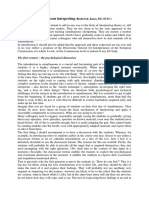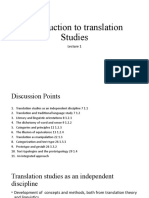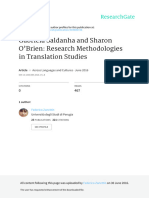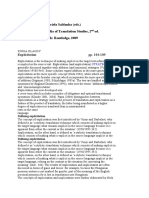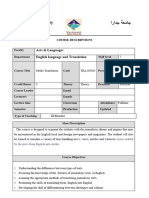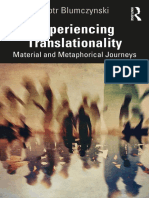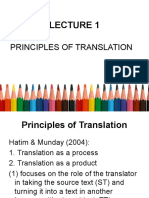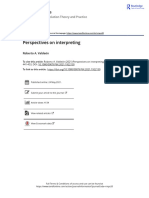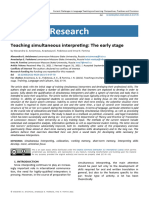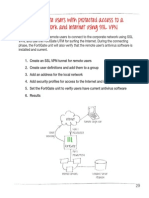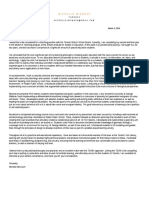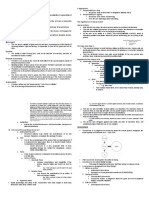Novice Interpreters Competenc
Uploaded by
Yahayra Araujo CernaNovice Interpreters Competenc
Uploaded by
Yahayra Araujo CernaISSN 1799-2591
Theory and Practice in Language Studies, Vol. 13, No. 6, pp. 1379-1393, June 2023
DOI: https://doi.org/10.17507/tpls.1306.06
Novice Interpreters: Competencies and Training
Needs
Baleigh Qassim AL- Wasy
Department of English, Sana'a University, Yemen
Ahmed Mohammed Moneus
Department of Translation, Sana'a University, Yemen
Abstract—The lack of practical training in interpreting courses at universities represents considerable
challenges. Many university interpretation students suffer from inadequate training that prepares them for
the interpretation market. Graduates will not be hired as interpreters unless they have high-quality
interpretation skills. In spite of the crucial role of consecutive and simultaneous interpreting training in
preparing well-qualified interpreters, researchers have not treated this role in much detail. The present study
investigates the impact of consecutive and simultaneous interpreting training on fostering EFL learners'
interpretation competencies. The study sample consists of 26 students from the fourth level in the Translation
Department, UST, Yemen, who are studying consecutive and simultaneous interpreting. The students will be
exposed to extensive training in interpreting courses, including many practical activities such as role-playing,
focus group discussion, simulation, pairs work, discussion, and interaction. A smart screen, PowerPoint
presentation, live videos, and EU Interpretation training toolbox will be used. To evaluate the impact of this
intensive training on developing interpreters' competencies, the students' interpretation performance will be
mid-assessed during training and post-assessed at the end of the training, using standard criteria in evaluating
interpreters. The study will pave the way for addressing the weakness of interpretation students in the
interpreting field.
Index Terms—training, consecutive, simultaneous, interpreting, assessment
I. INTRODUCTION
Translation departments in many universities seek to develop their programs and design course descriptions for new
subjects that language experts see as crucial for undergraduate students, but most of these courses focus on the
theoretical part with little attention paid to the practical training side. According to Johnson (2016), an interpretation
training program aims to generate qualified interpreters capable of participating in professional work in the field. Wong
(2007) suggested that if the Chinese people had given the Opium War interpreter training more consideration, the
outcome might have been very different. Training new interpreters will improve their skills, help them build their
vocabularies and improve their ability to analyze what they hear. It will also help them develop a good memory, which
will help them remember things and give the right message. These abilities may be developed through specific training
or previous experience in simultaneous interpretation.
The study will be limited to investigating the competencies novice Arab interpreters should have and identifying the
training needs according to these competencies. The findings of this study will be helpful as guidelines for interpreters
engaged in translating interviews, conferences and other kinds of simultaneous translation. The competencies
investigated in this study can be used in courses designed for teaching interpretation. The recommendation of study will
serve as a vital starting point for studies in the interpretation area and will be instructive for translation departments at
various universities.
To summarize, the current study aims to:
1) investigate the impact of consecutive interpreting training on fostering EFL learners' consecutive interpretation
competencies.
2) investigate the impact of simultaneous interpreting training on fostering EFL learners' simultaneous
interpretation competencies.
It tries to answer the following two questions:
RQ1: What is the impact of consecutive interpreting training on fostering EFL learners' consecutive interpretation
competencies?
RQ2: What impact does simultaneous interpreting training have on fostering EFL learners' simultaneous
interpretation competencies?
Litrature Review
© 2023 ACADEMY PUBLICATION
1380 THEORY AND PRACTICE IN LANGUAGE STUDIES
Before going forward, it is necessary to comment on the exchangeable use of the terms "translation" and
"interpreting." "Translation" refers to the written translation, whereas "interpreting" refers to the oral translation.
However, this study uses the term "interpreting" to specify the verbal work of the interpreters because this study will
address the nature of interpreting work. As per Mikkelson and Jourdenais (2015, p. 1) "Interpreting is an activity that
has been practiced since time immemorial, but only recently has it been viewed as a field of academic study in and of
itself". A constantly growing area of study, the theory of interpreting examines many aspects of oral, written, and sign
language translating in various scops and fields. During the interpreting process, a spoken or signed message is
translated into another spoken or signed language while preserving the original language’s register and the meaning of
the content. According to Pöchhacker (2010), interpreting relates to a specific type of translational action. It is thus both
incorporated into the more general concept of translation and distinguished by its particular characteristics.
Before that, interpreting was described as a form of writing, Pöchhacker (2004), in his Introducing Interpreting
Studies book, indicated that translation is a type of writing process, and therefore the translation process preceding
writing is distinguished from other types of translation by its immediacy. Following the research of the German scholar
Otto Kade, the source text is typically provided only once and cannot be retrieved. On the other hand, the target
language is typically produced under time constraints, preventing interpreters from editing or revising their work as they
might be able to do with different types of (written) translation.
Pöchhacker (2016) defines interpreting as a type of translation in which a first and final rendition in a different
language is created based on the presentation of an utterance in the source language only once. While interpreting may
be considered a certain type of "translation," he stressed that "interpretation" generally refers to all activities that
involve translation.
Historical Background of Interpretation
Human beings first used the discipline of interpreting long before writing and translation (in writing) were developed;
according to Pöchhacker (2016), the concept of interpreting is articulated by words in several Indo-European languages
whose etymologies are substantially independent of those of (written) translation. Ferreira and Schwieter (2022)
indicated that research in translation and interpreting studies (TIS) has advanced rather quickly, mostly as a result of
borrowing from fields with longer, more established histories.
Some researchers and translation scholars argue that the science of interpretation started in the middle of the last
century, which supports their argument. However, other researchers and translation scholars disagree with this argument.
They were supported by Gile (2009) indicated that the study of interpreting had been studied for nearly half (50 years).
It evolved into a viable entity in the 1980s and 1990s from an embryonic state in the 1950s and 1960s. It now depends
on the work of a community of a few dozen regular actors and hundreds of scattered research authors, including many
students who write graduation theses every year. It also reaps the benefits of translation studies energy, which has
grown dramatically over the past three decades.
According to Garzone and Viezzi (2002), interpreting was connected to various subjects and perspectives. In the past,
research in interpreting was characterized by various trends due to the interdisciplinary effort frequently required to
handle its varied dimensions. According to others, the period in which simultaneous translation developed and began to
be viewed as a science with its foundations and objectives began in the 1990s of the past centuries. Gile (2009) asserts
that the 1990s marked a new era in the study of interpreting in various ways. The 1990s saw the birth of interpreting
studies, which marked the true beginning of those studies.
Consecutive and Simultaneous Interpreting
Consecutive interpreting involves interpreting in a conference context and requires the interpreter to listen to a
speech passage, jot down any important points, and then repeat the speech in the target language once the original
speaker has completed speaking. Alkhaldy and Alduhaim (2019) stated that the oldest and most challenging style of
interpreting is known as consecutive interpretation, in which the interpreter waits until the speaker has finished speaking
before translating what they have just said into the target language. This kind of interpretation necessitates certain
abilities from interpreters, such as intense listening and understanding abilities, note-taking strategies, good knowledge,
and a trained memory.
According to Mikkelson and Jourdenais (2015), interpreting has made communication between people of different
languages and cultures more smoothly throughout human history. Before the development of particular simultaneous
Interpreting (SI) equipment and subsequent simultaneous Interpreting (SI) practice in the middle of the 20th century,
what is now known as consecutive interpreting and whisper interpreting in the simultaneous mode were the most
common types used in spoken language. Consecutive Interpreting (CI) is the process of interpreting after the speaker
has completed one or more ideas in the source language and then pauses while the interpreter transmits that information
(Russell, 2005). According to Mikkelson and Jourdenais (2015), in terms of allowing the interpreter to interact and
clarify with participants, control the dialogical discourse, and assess the participants' physical circumstances and their
surroundings, consecutive Interpreting (CI) is more flexible than simultaneous Interpreting (SI).
Simultaneous interpretation was developed in the 1990s and quickly extended to conferences and other public
meetings. Pöchhacker (2016) confirms that simultaneous interpretation has been a practice since ancient times and is
connected to writing, interpreting, and understanding words. It is the most frequently used mode of interpreting in
© 2023 ACADEMY PUBLICATION
THEORY AND PRACTICE IN LANGUAGE STUDIES 1381
conference settings and involves the interpreter sitting in the booth and listening through the headset to what is going on
in the meeting room and simultaneously interpreting into a microphone what the delegates are saying in their
microphones. The representatives can hear the interpreter with the help of their headsets. According to Gillies (2019),
an interpreter interprets verbally in real-time while a speaker speaks in a meeting room microphone. The interpreter
listens through headphones from a soundproof booth, and the listeners in the room can hear the interpretation through
headphones. Mikkelson and Jourdenais (2015) stated that the first simultaneous interpreting system was developed by
Edward Filene and A. Gordon-Finlay in the early 1920s utilizing primitive telephone technology. This system was
known as telephonic interpreting equipment. However, it was not until the Nuremberg Trials in the fall of 1945 that
simultaneous interpretation was broadcast internationally. Interpreters had to take notes while a speech was being
delivered to reconstruct it in a different language after the speaker had completed it. Until then, interpreting at
multilingual conferences was often offered in consecutive modes.
Assessment of Novice Interpreters Scale (Panis)
To the best of the researchers' knowledge, there was no approved assessment available for novice interpreters.
Therefore, the researchers developed their criteria for evaluating novice interpreters based on their experiences as senior
interpreters and broad consultation with several other international professional interpreters. The development of the
scale's components also benefited from a few skills mentioned by Jones (2002) in his book "Conference Interpreting
Explained" and Gillies (2019) in his book "Consecutive Interpreting: A short course".
In the first semester of 2021, level four undergraduate students taking interpretation courses were the ones who
utilized the scale for the first time. This scale was used for a pre-and post-test, and based on the test's findings, the
researchers concluded that it effectively addressed novice interpreters' needs and competencies. The following year,
several dimensions were changed, and the second edition of this scale was developed. The Department of Translation at
the University of Science and Technology has approved the final scale as the evaluation tool to evaluate novice
interpreters in the profession.
In this study, ten key concepts for evaluating consecutive and simultaneous interpreters' performance are broken into
the following.
Consecutive Interpreters
For class (A), consecutive interpreters were evaluated by five key concepts. Accuracy, Knowledge, Concentration,
Note-Taking, and Intonation, which are chosen based on approved criteria in the interpretation field, have been chosen
as the criteria for evaluating interpreting performance.
Accuracy
The process of interpreting should get as close as possible to the original message of the speaker in terms of
capturing the text's essence and explaining what it means. Most codes of conduct for public service interpreting
prioritize accuracy above all other considerations (Gil-Bardaj, 2020). Indeed, when interpreting in consecutive mode,
interpreters should pay close attention to and ensure linguistically complete comprehension of thoughts or sequences of
concepts before speaking on their own (Gile, 2009). Consecutive interpreters must keep the original text's meaning
without changing or destroying essential parts of speech. Following Lee (2008), the degree of accuracy may be
indicated by the number of variations, such as omissions, additions, reasonable alterations, or incorrect interpretations
of the speaker's meaning and purpose, that is noticed while interpreting performance.
Knowledge
Understanding the core of meaning is a fundamental skill for any consecutive interpreter. Interpreting professionally
and in the classroom requires a solid understanding of the speaker's speech. Novice interpreters may transfer into
professional practice by grasping text nuances and understanding speech flow. Knowing the essential parts of speech
content will facilitate the interpreting process. The interpreter should be seated or standing near the speaker to interpret
what they are saying (Morin, 2005). Interpreters require a lot of knowledge and a diverse range of intellectual interests.
They should constantly adhere to the most recent information.
Concentration
Understanding the significance of making connections between the notes and what the speaker is saying is crucial for
novice interpreters. It is a sort of concentration. The concentration process may be broken down into two phases, which
interpreters should follow when providing their services; the most important of which is analyzing. Analyzing is one of
the best ways to build a logical connection between speech parts is to analyze the speech while one is interpreting. In
terms of Lie (2015), looking at the purpose of each speech segment might help the interpreter analyze it more
thoroughly and, as a result, better interpret it. Gillies (2019) asserts the performance evaluation of another interpreter. It
may also simplify your grasp of how interpreting works in advantageous ways. When it comes time to interpret, look at
the structure and logical flow to see what makes sense.
Note-Taking
© 2023 ACADEMY PUBLICATION
1382 THEORY AND PRACTICE IN LANGUAGE STUDIES
Consecutive interpretation requires note-taking, but it is not the only component. According to Gillies (2019), taking
notes is a critical part of consecutive interpreting. Professional interpreters use this method to jot down information
when they attend lengthy meetings or speeches where it is necessary to record information and focus on political
contexts where it is essential to record every single detail. However, for accurate interpreting, note-taking was advised
to be used. Taking notes sometimes involves using symbols, numbers, abbreviations, phrases, and other symbols.
Interpreters take notes to analyze and remember the material they are hearing, record things they cannot remember, and
appropriately present the speech (Gillies, 2019).
Intonation
The methods employed to produce more melodic and cohesive speech are known as "naturalization of sound speech".
According to Li (2015), interpreters resort to paralinguistic cues, such as the rising or falling of intonation, to achieve
speech cohesion and help listeners disambiguate the utterance's intended meaning. In view of Gillies (2019) indicates
that the interpreter's voice should seem natural and fluid. Their listeners will feel more confident as a result. Avoid
sounding anxious and unsure, as this will have the opposite impact. Try to be communicative as one straightforward
approach to accomplish this. Therefore, interpreters should remember that the talent they are learning is communication
when they need to pay additional attention to it.
Simultaneous Interpreters
For class (B), Simultaneous interpreters are evaluated by five key concepts. Confidence, anticipation, recalling
information, using memory, and paraphrasing are chosen based on approved criteria in the interpretation field for
evaluating interpreting performance.
Confidence
It entails confidence in the interpreter's abilities and capacity to carry out their duties. This is the first and most
important talent, particularly for novice interpreters. With more self-confidence, one could raise his talents and devote
himself to achieving goals that he could only imagine, establishing bigger goals, and creating bigger plans. As a result,
most individuals have low self-confidence, while many others have none (Tracy, 2012). The bulk of novice interpreters
at the start of their professions experienced this. The effects of psychological variables on their performance might be
either positive or negative. Therefore, at every point of their lives, interpreters must have a strong sense of self-
confidence. Many students need public speaking training, and the main motivation virtually all of them cited was that
they wished to overcome their anxiety, be able to think on their feet, and talk in front of any size group with confidence
and ease (Carnegie, 2021).
Anticipation
The interpreter anticipates the incoming text and creates a target text segment before it is uttered by the speaker,
especially when the two working languages have asymmetrical structures SOV vs SVO languages Li (2015). According
to Gillies (2019), anticipation is the process through which the interpreter anticipates the spoken text and prepares the
target text before it is delivered. This is done by exploiting linguistic cues. In other words, the interpreter anticipates the
input text by producing the target language first. Create a sense of anticipation by attempting to guess what the speakers
will say based on the circumstances in which they will speak. As per Al-Salman and Al-Khanji (2002), anticipation is
the ability to anticipate what will happen next and modify the information to present it in the TT in the most relevant
manner.
Recall Information
Reformulating is a term used to represent a means of recalling information already in the interpreter's head. To make
speech more coherent and understandable, the interpreter tries to reformulate the speech's substance using specific
words and signs. It is used when interpreters cannot comprehend a speech segment or reformulate it in the target
language. It is good to reformulate the message in a less precise manner by using a superordinate in the case of a single
word or by creating a more general segment in the case of a whole. According to Gillies (2019), if one has not
documented the original words or cognates, it will also encourage reformulation, decreasing language interference.
Reformulating is synonymous with paraphrasing and refers to expressing the same message using alternative words.
Using Memory
Echoic memory, short-term or working memory, and long-term memory are the three categories of memory that
Setton and Dawrant (2016) propose for the interpreter task. The interpreters should work on it since it only takes the
memory a few seconds to process each one. Therefore, one of their responsibilities is to develop the memory's ability to
function well under pressure. According to Kriston (2012), training short-term memory must be continually practised
for the interpreter to understand the source language better because the first stage of recalling information involves
short-term memory, which retains speech for a few seconds before transmitting it to long-term memory or ignoring it.
Consequently, the degree of interpretation will rise, and the outcomes will likely be very satisfying. Understanding is
the first step in effective interpreting; as a result, memory training should be offered early in the interpreter training
© 2023 ACADEMY PUBLICATION
THEORY AND PRACTICE IN LANGUAGE STUDIES 1383
process. Because consecutive interpreting uses memory for longer than simultaneous interpreting, memory behaves
differently in each case (Zhong, 2003).
Paraphrasing
By bringing the speech's content to its essence and rephrasing it in the interpreters' own words, paraphrasing is a
technique that is frequently used to make speeches more understandable and logical while avoiding repetition and being
lost in translation. In conference interpreting, paraphrasing has evolved to mean describing a notion for which one does
not know the exact word translation, even if one exists. For instance, if one does not know the correct word, one might
paraphrase the fairing on a satellite launch vehicle to mean protective cover. As a result, paraphrasing represents a
coping technique and carries a marginally unfavourable meaning (Gillies, 2019).
Interpretation and Training
A large and growing body of literature has investigated the role of training in developing interpretation. Orlando
(2010) addressed the guidelines for taking notes and the different kinds of notes during consecutive interpreting training.
It was highlighted that nothing had been done to develop proper methods for evaluating the progressive development of
such systems and note-taking abilities. The study concluded that using technology is crucial in teaching interpretation
students note-taking techniques during concurrent interpreting instruction, was advised.
In the same vein, Ribas (2012) investigated the subject of strategic competency in interpreting. It evaluates the
students' perspective of whether and how they have successfully finished the work by describing and categorizing the
solutions used to overcome the challenges. The findings claim that the more knowledge we have about the
interpretation processes that are gained and developed, the better a foundation we will have for developing training
parameters that address strategic competency and reflective practice.
Furthermore, Hill et al. (2014) provide an overview of the rationale, methods, and analyses used in common across
three studies conducted to teach insight skills (immediacy, challenges, and interpretation, respectively) to undergraduate
students in helping skills courses. The three presented studies were reviewed and examined to conclude that although
supporting skill development seems vital for building the groundwork for future practice, there is a lack of solid
research to support this claim.
In a unique approach to teaching and learning exploration skills for interpretation students, Jackson et al. (2014)
trained 128 undergraduate students in helping skills to apply the insight skill of interpretation. The findings of the study
indicated that students with the least self-efficacy gained the greatest beginning self-efficacy, but they had the highest
levels of self-efficacy by the conclusion of training. However, the students with more experience assisting others had
the greatest increases in self-efficacy.
In view of that, Dong et al. (2019) examined the issue of interpreting strategy acquisition. The study focused on the
acquisition of interpreting strategies. According to data analyses of interpreting performance, students in interpreting
training continued to use the strategies that their instructors recommended more frequently than those they were advised
to use cautiously or not at all and less frequently than those they were not advised to use at all. These findings imply
that strategy training is efficient and that credible strategy acquisition may occur.
II. METHODOLOGY
The study used a quantitative methodology to gather and analyze data. It is an experimental study intended to
determine how applying specialized training affects teaching level four students in interpreting courses. Those courses
are trained by a senior interpreter who has broad experience in the interpreting field.
Sample
Students at the Level 4 Translation Department in the Faculty of Human and Social Sciences of the University of
Science and Technology in Al Hudaydah, Yemen, made up the sample of the study. The training occurred during the
second semester of the academic year 2022/2023. The total population of the study is 26 students who form the sample
of the study. Students at level four are selected because they have taken several interpreting courses and are expected to
graduate soon.
Treatment
In the first semester of the academic year 2022–2023, Level four students in the interpreting course at University of
Science and Technology (UST) participated in the experimental study. During the two-month training, the participants
attended (10) workshops that included extensive practical training, including role plays, video stimulation, focus groups,
and discussion. The teacher conducted a pre-test in the first workshop to evaluate the students' performance before
training. The post-test was conducted at the end of training to evaluate how well the training program works and how
participants' interpretation abilities improved after training. The teacher used a unique training scale recognized by
professional interpreters to assess students' performance. Data were analyzed and scored after the post test.
Strategies and Methods of Training
Several strategies were used to develop students' performance as follows.
© 2023 ACADEMY PUBLICATION
1384 THEORY AND PRACTICE IN LANGUAGE STUDIES
Simulations: Students ask to simulate the video speaker and conduct an interpretation
Shadowing: students listen to the speaker and count from one to hundred descended and ascended
Role play: students act as speakers and interpreters and present before their partners.
Performance: students prepare the same condition and view as shown in T.V.
EU Interpretation training toolbox: useful tools and practical training resources to help interpreters develop
their simultaneous and consecutive interpreting abilities were prepared by the European Commission has
developed
Group work: students work in a group to discuss and swap information.
Discussion: students have a broad discussion about each detail of the content.
Debate: students freely put their own opinion and make arguments.
Instruments of the Study
In this study, the checklist assessment was used. The observation checklist included ten scale items to evaluate the
performance of interpretation students during pre-and post-training. The Performance Assessment of Novice
Interpreters Scale (PANIS) was used twice pre and after training. The data was collected through the above instrument
and analyzed quantitatively; the students' scores analyzed and compared using the SPSS program.
Procedures of the Study
During ten weeks, a number of 26 students received extensive training in consecutive and simultaneous interpreting.
The teacher used many techniques and strategies in training interpretation, and the training was conducted in two phases
as follows:
Phase I
The first five workshops were signified for consecutive interpreting training; each workshop lasted four hours. A pre-
test was conducted to evaluate the performance of students before training. Then, the teacher gave an overview of the
training's content, strategies, methods, activities, and process and split the students into two groups to share the
activities. The teacher gave each pair of group members a task, which included choosing a short video clip and putting
on a role play about consecutive interpreting. Students practised consecutive interpreting daily. There were a lot of role-
plays, simulations, workshops, talks, presentations, dialogues, virtual EU training classes, debates, and competitions.
After five workshops, a post-assessment was conducted to evaluate the students' performance using the same scales and
content as the pre-assessment.
Phase II
The second round of training consisted of five training workshops in simultaneous interpreting, each lasting four
hours. Before the training, a pre-test was conducted to evaluate how well the students performed. Then, an overall
presentation was made to the class outlining the topics, exercises, and distribution methods that will be applied.
Furthermore, each student had the opportunity to practice performing regularly and role-playing during the second and
succeeding workshops. At the end of the training, a post-program assessment was conducted to evaluate the student's
performance.
III. RESULTS AND DATA ANALYSIS
This section presents the analysis of the data collected from the study participants to answer the study questions. It
deals with two main points: the effect of the Assessment of Consecutive and Simultaneous Interpreters' performance
and the significant differences in the means dimension between the pre-test and post-test.
Twenty-six students were subjected to pre–post assessments, and the students were trained for two months (10
workshops) were conducted. The trainees were tested in the first program to identify the needs and challenges of
training in the interpretation field and to evaluate the trainees' ability to conduct the interpretation in the field. Another
post-assessment was conducted in the final of training to evaluate trainees' performance and to evaluate students
understanding and skills in simultaneous and consecutive interpretation. After correcting and scoring the tests, data
were inserted into SPSS and manipulated using the paired-sample t-test.
This section compares the mean dimensions between the pre-assessment of consecutive and simultaneous
interpreters' performance and the post-assessment of consecutive and simultaneous interpreters' performance.
Rq1: What Is The Impact Of Consecutive Interpreting Training On Fostering Efl Learners' Consecutive Interpretation
Competencies?
To answer the first question, the mean dimensions of the pre-assessment of consecutive interpreters' performance
were compared with those of the post-assessment of consecutive interpreters' performance.
A Pre-Role Play of Consecutive Interpreters
© 2023 ACADEMY PUBLICATION
THEORY AND PRACTICE IN LANGUAGE STUDIES 1385
TABLE 1
FREQUENCY DISTRIBUTION– PRE- A ROLE PLAYS OF CONSECUTIVE INTERPRETERS
Accept Good V. Good Outstanding
Pre-Role Play of Consecutive Interpreters
N % N % N % N %
Accuracy 9 34.6% 13 50.0% 4 15.4% 0 0%
Knowledge 6 23.1% 15 57.7% 4 15.4% 1 3.8%
Concentration 12 46.2% 13 50.0% 1 3.8% 0 0%
Note-Taking 21 80.8% 5 19.2% 0 0% 0 0%
Intonation 23 88.5% 3 11.5% 0 0% 0 0%
Table 1 shows that the trainees ranged in the first dimension, “Accuracy” in (good scale), according to pre-
assessment (50%). Also, in the second dimension, "Knowledge" gained (57.7%), and in the third dimension
"Concentration" gained (50.0%). While in the fourth dimension, the trainees range in (acceptable scale) with (80.8%)
and in the fifth dimension ranging in (88.5%).
90.0% 88.5%
80.8%
80.0%
70.0%
60.0% 57.7%
50.0% 50.0%
50.0% 46.2%
40.0% 34.6%
30.0% 23.1%
20.0% 15.4% 15.4%
19.2%
11.5%
10.0% 3.8% 3.8%
0.0% 0.0% 0.0% 0.0% 0.0% 0.0%
0.0%
Accuracy Knowledge Concentration Note-Taking Intonation
Accept Good V. Good Outstanding
Figure 1. Frequency Distribution– pre- a role Plays of Consecutive Interpreters
TABLE 2
DESCRIPTIVE STATISTICS OF PRE- A ROLE PLAY OF CONSECUTIVE INTERPRETERS
Pre-Role Play of Consecutive Interpreters Mean SD Percent
Accuracy 1.81 .694 45.3%
Knowledge 2.00 .748 50.0%
Concentration 1.58 .578 39.5%
Note-Taking 1.19 .402 29.8%
Intonation 1.12 .326 28.0%
Consecutive 20 7.81 1.470 39.1%
The pre-role play of consecutive interpreters designed by five dimensions. The results of the descriptive statistics of
the pre-role play of consecutive interpreters are presented in table (2) and figure (2). The results show that (Knowledge)
got the first rank with a mean of 2.0 and a standard deviation of (0.748), the highest percentage (50%) of respondents
agreed. The intonation ranked last with a mean of (1.12) and standard deviation of (0.326) with a degree of 28%. The
overall average of the variables is (7.81), and the standard deviation is (1.470) with a degree of 39.1%.
8 7.81
2 1.81 2
1.58
1.19 1.12
0
Figure 2. Descriptive Statistics of pre- a role Play of Consecutive Interpreters
Post Role Play of Consecutive Interpreters
© 2023 ACADEMY PUBLICATION
1386 THEORY AND PRACTICE IN LANGUAGE STUDIES
TABLE 3
FREQUENCY DISTRIBUTION– POST- A ROLE PLAY OF CONSECUTIVE INTERPRETERS
Accept Good V. Good Outstanding
Post- Role Play of Consecutive Interpreters
N % N % N % N %
Accuracy 1 3.8% 6 23.1% 9 34.6% 10 38.5%
Knowledge 2 7.7% 1 3.8% 15 57.7% 8 30.8%
Concentration 0 0% 4 15.4% 10 38.5% 12 46.2%
Note-Taking 1 3.8% 4 15.4% 8 30.8% 13 50.0%
Intonation 0 0% 4 15.4% 9 34.6% 13 50.0%
Table 3 revealed that most of participants in "Accuracy" item scored (38.5%) for outstanding dimension, and (57.7%)
in "Knowledge" item for V. Good dimension, and (46.2%) in "Concentration "for outstanding dimension. Similarly, in
"Note-Taking" and "Intonation" items scored (50.0%) for outstanding dimension.
60.0% 57.7%
50.0% 50.0%
50.0% 46.2%
40.0% 38.5%
34.6%
38.5%
34.6%
30.8% 30.8%
30.0%
23.1%
20.0% 15.4% 15.4% 15.4%
10.0% 7.7%
3.8% 3.8% 3.8%
0.0% 0.0%
0.0%
Accuracy Knowledge Concentration Note-Taking Intonation
Accept Good V. Good Outstanding
Figure 3 Frequency Distribution– post- a role Play of Consecutive Interpreters
TABLE 4
DESCRIPTIVE STATISTICS OF POST- A ROLE PLAY OF CONSECUTIVE INTERPRETERS
A Role Play of Consecutive Interpreters Mean SD Percent
Accuracy 3.08 .891 77.0%
Knowledge 3.12 .816 78.0%
Concentration 3.31 .736 82.8%
Note-Taking 3.27 .874 81.8%
Intonation 3.35 .745 83.8%
Consecutive 20 16.04 3.053 80.2%
The post-role play of consecutive interpreters has five dimensions. The results of the descriptive statistics of the post-
role play of consecutive interpreters are presented in table (4) and figure (4). The results show that (Intonation) got the
first rank with a mean of 3.35 and a standard deviation of (0.745) and the highest percentage (83.8%) of respondents
agreed. The accuracy ranked last with a mean of (3.08) and a standard deviation of (0.891) with a degree of 77%. The
overall average of the variables is (16.04), and the standard deviation is (3.053) with a degree of 80.2%.
20
16.04
15
10
5
3.08 3.12 3.31 3.27 3.35
0
Accuracy Knowledge Concentration Note-Taking Intonation Consecutive 20
Figure 4. Descriptive Statistics of post- a role Play of Consecutive Interpreters
Mean Dimensions for the Role-Play of Consecutive Interpreters in the Pre-Test and Post-Test
© 2023 ACADEMY PUBLICATION
THEORY AND PRACTICE IN LANGUAGE STUDIES 1387
TABLE 5
DESCRIPTIVE STATISTICS OF ROLE PLAY OF CONSECUTIVE INTERPRETERS IN THE PRE-TEST AND POST-TEST
Role play of consecutive interpreters Mean T-test P-value
Pre 1.81
Accuracy 5.312 0.000**
Post 3.08
Pre 2.00
Knowledge 5.975 0.000**
Post 3.12
Pre 1.58
Concentration 10.093 0.000**
Post 3.31
Pre 1.19
Note-Taking 10.415 0.000**
Post 3.27
Pre 1.12
Intonation 16.013 0.000**
Post 3.35
** Statistically significant at the level of 0.01
The Paired Samples Statistics test was used to determine whether there were differences between the pre and post-
tests. Because the percentages were higher in the post-tests for all dimensions, there was a significant difference
between the pre and post-tests, with a significance level of less than 0.000. This indicates that the training program
played a major role in these differences.
3.42 3.38
3.15 3.23 3.12 3.5
2.65 3
2.5
1.77 1.65 1.73 2
1.08 1.5
1
0.5
0
Post Pre Post Pre Post Pre Post Pre Post Pre
Paraphrasing Using Recall Anticipation Confidence
memory information
Figure 5. Descriptive Statistics of Role Play of Consecutive Interpreters in the Pre-test and Post-test
TABLE 6
T=TEST PAIRED SAMPLES STATISTICS OF ROLE PLAY OF CONSECUTIVE INTERPRETERS IN THE PRE-TEST AND POST-TEST
Consecutive
N Mean Std. Deviation T Sig.
interpreters
Pretest 26 7.81 1.470
13.203 0.000*
Posttest 26 16.04 3.053
** Statistically significant at the level of 0.01
In order to determine whether there were differences between the pre and post-test concerning consecutive
interpreters, the Paired Samples Statistics test was used. The results revealed a significant difference between the pre
and post test, where the significance level was less than 0.000. This indicates that the training program has a role
because the percentages were higher in the post-test. The average score on the post-test in successive interpreters was
16.04, compared to 7.81 on the pre-test.
© 2023 ACADEMY PUBLICATION
1388 THEORY AND PRACTICE IN LANGUAGE STUDIES
16.04 20
15
Pretest
7.81
Posttest 10
0
Posttest Pretest
Figure 6. T=test Paired Samples Statistics of Role Play of Consecutive Interpreters in the Pre-test and Post-test
What impact does simultaneous interpreting training have on fostering EFL learners' simultaneous interpretation
competencies?
To answer the second question, the mean dimensions of the pre-assessment of simultaneous interpreters' performance
were compared with those of the post-assessment.
A Pre-Role Play of Simultaneous Interpreters
TABLE 7
FREQUENCY DISTRIBUTION– PRE- A ROLE PLAY OF SIMULTANEOUS INTERPRETERS
Accept Good V. Good Outstanding
Pre-Role Play of Simultaneous interpreters
N % N % N % N %
Confidence 9 34.6% 17 65.4% 0 0% 0 0%
Anticipation 8 30.8% 17 65.4% 1 3.8% 0 0%
Recall information 9 34.6% 17 65.4% 0 0% 0 0%
Using memory 11 42.3% 10 38.5% 5 19.2% 0 0%
Paraphrasing 24 92.3% 2 7.7% 0 0% 0 0%
Table 7 shows that (Confidence), according to most of the participants, scored (65.4%) in Good dimension; similarly,
for (Anticipation) and (Recall information). In comparison, most participants scored (42.3%) in the acceptance
dimension for (using memory) and (92.3%) for (Paraphrasing).
100.00%
92.30%
80.00%
65.40% 65.40% 65.40%
60.00%
42.30%
40.00% 34.60% 34.60%
38.50%
30.80%
20.00% 19.20%
7.70%
3.80%
0% 0% 0% 0% 0% 0% 0% 0%
0.00%
Confidence Anticipation Recall information Using memory Paraphrasing
Accept Good V. Good Outstanding
Figure 7. Frequency Distribution– pre- a role Play of Simultaneous Interpreters
TABLE 8
DESCRIBATIVE STATISTICS OF PRE A ROLE PLAY OF SIMULTANEOUS INTERPRETERS
A Role Play of Simultaneous interpreters Mean SD Percent
Confidence 2.65 .485 66.3%
Anticipation 1.73 .533 43.3%
Recall information 1.65 .485 41.3%
Using memory 1.77 .765 44.3%
Paraphrasing 1.08 .272 27.0%
Simultaneous 20 8.88 1.275 44.4%
© 2023 ACADEMY PUBLICATION
THEORY AND PRACTICE IN LANGUAGE STUDIES 1389
The pre-role play of simultaneous interpreters has five dimensions. The results of the descriptive statistics of the pre-
role play of simultaneous interpreters are presented in table (8) and figure (8). The results show that (Confidence) got
the first rank with a mean of 2.65 and a standard deviation of (0.485); the highest percentage (66.3%) of respondents
agreed. The paraphrasing ranked last with a mean of (1.08) and standard deviation of (0.272) with a degree of 27.0%.
The overall average of the variables is (8.88), and the standard deviation is (1.275) with a degree of 44.4%.
9 8.88
8
7
6
5
4
3
2.65
2 1.73 1.77
1.65
1 1.08
0
Confidence Anticipation Recall Using memory Paraphrasing Simultaneous
information 20
Figure 8. Descriptive Statistics of pre- a role Play of Simultaneous Interpreters
Post Role Play of Simultaneous Interpreters
TABLE 9
FREQUENCY DISTRIBUTION– POST- A ROLE PLAY OF SIMULTANEOUS INTERPRETERS
Accept Good V. Good Outstanding
Post-Role Play of Simultaneous interpreters
N % N % N % N %
Confidence 1 3.8% 2 7.7% 16 61.5% 7 26.9%
Anticipation 0 0% 4 15.4% 12 46.2% 10 38.5%
Recall information 0 0% 6 23.0% 10 38.5% 10 38.5%
Using memory 0 0% 4 15.4% 8 30.8% 14 53.8%
Paraphrasing 0 0% 3 11.5% 9 34.6% 14 53.8%
Table 9 shows that most of the participants scored (61.5%) in "Confidence" and (46.2%) in "Anticipation "for V.
Good dimension, and (38.5%) in "Recall Information" for V. Good and outstanding dimensions. While "using memory"
and "Paraphrasing" scored the same percentage (53.8%) in outstanding dimension.
70.0%
61.5%
60.0%
53.8% 53.8%
50.0% 46.2%
40.0% 38.5% 38.5%
38.5%
34.6%
30.8%
30.0% 26.9%
23.0%
20.0% 15.4% 15.4%
11.5%
10.0% 7.7%
3.8%
0.0% 0.0% 0.0% 0.0%
0.0%
Confidence Anticipation Recall Using memory Paraphrasing
information
Accept Good V. Good Outstanding
Figure 9. Frequency Distribution– post- a role Play of Simultaneous Interpreters
© 2023 ACADEMY PUBLICATION
1390 THEORY AND PRACTICE IN LANGUAGE STUDIES
TABLE 10
DESCRIPTIVE STATISTICS OF POST- A ROLE PLAY OF SIMULTANEOUS INTERPRETERS
A Role Play of Simultaneous interpreters Mean SD Percent
Confidence 3.12 .711 78.0%
Anticipation 3.23 .710 80.8%
Recall information 3.15 .784 78.8%
Using memory 3.38 .752 84.5%
Paraphrasing 3.42 .703 85.5%
Simultaneous 20 16.31 2.936 81.6%
The post-role play of simultaneous interpreters by five dimensions. The results of the descriptive statistics of the
post-role play of simultaneous interpreters are presented in table (10) and figure (10). The results show that
(Paraphrasing) got the first rank with a mean of 3.42 and a standard deviation of (0.703) the highest percentage (85.5%)
of respondents agreed. The confidence ranked last with a mean of (3.12) and a standard deviation of (0.711) with a
degree of 78.0%. The overall average of the variables is (16.31), and the standard deviation is (0.936) with a degree of
78.0%.
18
16 16.31
14
12
10
8
6
4 3.42
3.12 3.23 3.15 3.38
2
0
Confidence Anticipation Recall Using memory Paraphrasing Simultaneous 20
information
Figure 10. Descriptive Statistics of post- a role Play of Simultaneous Interpreters
Mean Dimensions for the Role-Play of Simultaneous Interpreters in the Pre-Test and Post-Test
TABLE 11
DESCRIPTIVE STATISTICS OF ROLE PLAY OF SIMULTANEOUS INTERPRETERS IN THE PRE-TEST AND POST-TEST
Role play of simultaneous interpreters Mean T-test P-value
Pre 2.65
Confidence 2.739 0.011*
Post 3.12
Pre 1.73
Natural intonation 8.446 0.000*
Post 3.23
Pre 1.65
Recall information 7.164 0.000*
Post 3.15
Pre 1.77
Using memory 8.380 0.000*
Post 3.38
Pre 1.08
Paraphrasing 16.053 0.000*
Post 3.42
** Statistically significant at the level of 0.01
The pre and post-tests were compared using the Paired Samples Statistics test to determine whether there were any
differences. The results revealed a significant difference between the two tests, with a significance level of less than
0.000. This indicates that the training program played a role, as all dimensions had higher post-test percentages.
© 2023 ACADEMY PUBLICATION
THEORY AND PRACTICE IN LANGUAGE STUDIES 1391
3.5
3
2.5
2
1.5
1
0.5
0
Post Pre Post Pre Post Pre Post Pre Post Pre
Paraphrasing Using Recall Anticipation Confidence
memory information
Figure 11. Descriptive Statistics of Role Play of Simultaneous Interpreters in the pretest and pos
TABLE 12
T=TEST PAIRED SAMPLES STATISTICS OF ROLE PLAY OF SIMULTANEOUS INTERPRETERS IN THE PRE-TEST AND POST-TEST
Simultaneous
N Mean Std. Deviation T Sig.
interpreters
Pretest 26 8.88 1.275
12.107 0.000*
Posttest 26 16.31 2.936
** Statistically significant at the level of 0.01
The Paired Samples Statistics test results were used to determine whether there were differences between the pre and
post-test with regard to simultaneous interpreters. The results showed that there is a significant difference between the
pre and post-test, where the significance level was less than 0.000, and this means that the training program has a role to
play because the percentages were higher in the post-test, the simultaneous interpreters averaged 16.31, while in the
pre-test, they were 8.88.
16.31 20
15
Pretest 8.88
Posttest 10
0
Posttest Pretest
Figure 12. T=Test Paired Samples Statistics of Role Play of Simultaneous Interpreters in the Pre-test and Post-test
IV. DISCUSSION
The present study was designed to explore the role of training EFL learners in consecutive and simultaneous
interpreting in promoting their interpretation competencies.
The first question in this study sought to determine the effect of consecutive interpreting training on fostering EFL
learners' consecutive interpretation competencies; the consecutive interpreters' competencies targeted in this study were:
Accuracy, knowledge, concentration, note-taking, and intonation. The results revealed that students showed a better
performance of the five competencies in the post-assessment when compared to their performance in the pre-assessment.
For example, out of the 26 participants (23) students were marked as "accept" and (0) student was given "outstanding"
in the pre-assessment of 'intonation', whereas (0) student was given "accept" and (13) students were marked as
© 2023 ACADEMY PUBLICATION
1392 THEORY AND PRACTICE IN LANGUAGE STUDIES
"outstanding" in the post-assessment of this competency. This result indicates that the training sessions have a crucial
role in improving the five consecutive interpretation competencies. This result supports the idea of Ribas (2012), who
reported better interpretations for interpreters with better knowledge of the strategies and competencies of interpretation.
The results also showed that none of the participants was given "v.good" or "outstanding" in the pre-assessment of both
'note-taking' and 'intonation', whereas, in the post-assessment, these two competencies were marked as "v.good" or
"outstanding" for most of the participants. In contrast to the earlier findings, no evidence of development is found in
learners' note-taking abilities due to interpretation training, as stated in Orlando's (2010) study.
The second question in this study tried to identify the impact of simultaneous interpreting training on fostering EFL
learners' simultaneous interpretation competencies; the simultaneous interpreters' competencies considered for this
study were: Confidence, anticipation, recalling information, using memory, and paraphrasing. The results indicated that
students' performance of the five competencies in the post-assessment is much better than in the pre-assessment. For
example, no one of the 26 participants was marked as "outstanding" in the pre-assessment of the five competencies
(confidence, anticipation, recalling information, using memory, and paraphrasing), whereas (7, 10, 10, 14, 14) students
were given "outstanding" in the post-assessment of these competencies, respectively ordered. This result indicates that
the training sessions helped develop the five simultaneous interpretation competencies. Besides, it also showed that
training sessions were more effective in improving students' abilities to paraphrase and use their memories than
promoting their self-confidence.
This improvement in both consecutive and simultaneous interpretation competencies may be attributed to the
variation in the training activities. The participants went through a lot of activities, including role plays, video
stimulation, focus groups, and discussion. The observed improvement could also be due to the nature of the training
program, its valuable content, and its various methods. The students' weak performance in 'note taking' and 'intonation'
in the pre-assessment of consecutive interpretation can be explained in terms of the difficulty of these two competencies.
In the case of simultaneous interpretation, the low improvement in self-confidence can be due to the focus of the
training. Throughout this training, the researchers focused on the practical aspects, not the psychological ones, though
they included them to some extent.
The above results indicate the importance of training to have better interpretation versions. The present findings seem
consistent with other research, which assures the importance of training to achieve better interpretation (Jackson et al.,
2014; Hill et al., 2014).
V. CONCLUSIONS
This investigation aimed to determine the effect of interpretation training on fostering the students' consecutive and
simultaneous interpretation competencies. The findings of this investigation suggest that the interpretation training
program has affected the participants positively and enhanced their interpretation abilities with regard to the targeted
competencies of both consecutive and simultaneous interpretation. There is a statistically significant difference between
the pre and post-assessments of the participants' consecutive and simultaneous interpretation competencies in favour of
the post-assessment.
The results of this study support the idea that both consecutive and simultaneous interpreters still need some
interpretation training. In spite of their good performance in general, interpreters could benefit from the training
program of this study in improving their consecutive and simultaneous interpretation competencies. Moreover, the
findings of the study enhance the readers' understanding of the most important competencies for consecutive, as well as
simultaneous, interpretations. They draw an obvious way for those serious about developing such skills.
ACKNOWLEDGEMENTS
This research is funded by the Literature, Publishing and Translation Commission, Ministry of Culture, Kingdom of
Saudi Arabia, which is part of the Arab Observatory in the field of translation.
REFERENCES
[1] Alduhaim, A., & Alkhaldy, M. (2019). Interpreting in the Libyan Uprising: A Study of Interpreting Strategies from Arabic to
English. Advances in Language and Literary Studies, 10(5), 36-42. doi:10.7575/aiac.alls.v.10n.5p.36
[2] Al-Salman, S., and Al-Khanji, R. I. (2002). The native language factor in simultaneous interpretation in an Arabic/English
context. Meta: Journal des traducteurs/Meta: Translators' Journal, 47(4), 607-626.
[3] ArumíRibas, M. (2012). Problems and strategies in consecutive interpreting: A pilot study at two different stages of interpreter
training. Meta: journal des traducteurs/Meta: Translators' Journal, 57(3), 812-835. https://doi.org/10.7202/1017092ar
[4] Boot, W. R., Blakely, D. P., & Simons, D. J. (2011). Do action video games improve perception and cognition? Frontiers in
Psychology, 2(226), 1-6. doi:10.3389/fpsyg.2011.00226
[5] Chiesa, A., Calati, R., & Serretti, A. (2011). Does mindfulness training improve cognitive abilities? A systematic review of
neuropsychological findings. Clinical Psychology Review, 31(3), 449–464. doi:10.1016/j.cpr.2010.11.003.
[6] Carnegie, D. (2021). How to Develop Self Confidence and Improve Public Speaking. Prabhat Prakashan.
[7] Dong, Y., Li, Y., & Zhao, N. (2019). Acquisition of interpreting strategies by student interpreters. The Interpreter and
Translator Trainer, 13(4), 408-425. https://doi.org/10.1080/1750399X.2019.1617653
© 2023 ACADEMY PUBLICATION
THEORY AND PRACTICE IN LANGUAGE STUDIES 1393
[8] Ferreira, A., & Schwieter, J. W. (2022). Introduction to translation and interpreting studies. New Jersey: John Wiley & Sons.
ISBN:9781119685272, 1119685273
[9] Garzone, G., & Viezzi, M. (2002). Interpreting in the 21st century: Challenges and opportunities. Selected papers from the 1st
Forli conference on interpreting studies, 9-11 November 2000. John Benjamins Publishing.
[10] Gile, D. (2009). Basic concepts and models for interpreter and translator training. John Benjamins Publishing.
[11] Gile, D. (2001). Consecutive vs. simultaneous: Which is more accurate. Interpretation Studies, 1(1), 8-20.
[12] Gil-Bardají, A. (2020). Ethics, accuracy, and interpreting in social settings: Assessing a non-professional interpreter profile.
Translation and Interpreting Studies. The Journal of the American Translation and Interpreting Studies Association, 15(1),
132-152
[13] Gillies, A. (2014). Note-taking for consecutive Interpreting: A short course. Routledge.
[14] Gillies, A. (2019). Consecutive Interpreting: A short course. Routledge.
[15] Hill, C. E., Spangler, P. T., Chui, H., & Jackson, J. L. (2014). Training undergraduate students to use insight skills: Overview
of the rationale, methods, and analyses for three studies. The Counseling Psychologist, 42(6), 702-728.
[16] Jackson, J. L., Hill, C. E., Spangler, P. T., Ericson, S. K., Merson, E. S., Liu, J., ... & Reen, G. (2014). Training undergraduate
students to use interpretation. The Counseling Psychologist, 42(6), 778-799. https://doi.org/10.1177/0011000014542600
[17] Johnson, J. E. (2016). Effect of mindfulness training on interpretation exam performance in graduate students in interpreting.
University of San Francisco
[18] Jones, R. (2002). Conference interpreting explained (2nd ed.). Routledge. ISBN 9781900650571
[19] Kriston, A. (2012). The importance of memory training in interpretation. PCTS Proceedings Professional Communication &
Translation Studies, 5(1), 79-86.
[20] Lee, J. (2008). Rating scales for interpreting performance assessment. The Interpreter and Translator Trainer, 2(2), 165-184.
doi:10.1080/1750399x.2008.10798772
[21] Li, X. (2015). Putting interpreting strategies in their place: Justifications for teaching strategies in interpreter training. Babel,
61(2), 170-192.
[22] Mikkelson, H., & Jourdenais, R. (Eds.). (2015). The Routledge handbook of interpreting (p. 456). New York: Routledge.
[23] Morin, I. (2005). Strategies for new interpreters: Interpreting in the Indonesian environment. Translation journals and the
author.
[24] Orlando, M. (2010). Digital pen technology and consecutive interpreting: another dimension in note-taking training and
assessment. The Interpreters' Newsletter, 15, 71 - 86.
[25] Pöchhacker, F. (2016). Introducing interpreting studies (2nd ed.). Abingdon, Oxon,: Routledge, Taylor & Francis Group.
[26] Pöchhacker, F. (2004). Introducing interpreting studies (1st ed.). London: Routledge. ISBN 0-415-26886-9 (hbk)
[27] Pöchhacker, F. (2010). Interpreting. In Y. Gambier, & L.v.Doorslaer(Eds.), Handbook of Translation Studies Volume 1 (pp.
158–172). John Benjamins.
[28] Russell, D., (2005). Consecutive and simultaneous interpreting. In: T. Janzen, ed. Topics in Signed Language Interpreting.
Amsterdam: John Benjamins. pp. 135–64.
[29] Setton, R., & Dawrant, A. (2016). Conference Interpreting: A Trainer's Guide, Amsterdam:Benjamins.
[30] Tracy, B. (2012). The power of self-confidence: Become unstoppable, irresistible, and unafraid in every area of your life. John
Wiley & Sons.
[31] Wong, L. W.-C. (2007). Translators and Interpreters during the Opium War between Britain and China (1839-1842). In
Translating and Interpreting Conflict (pp. 41-57). Brill Rodopi. https://doi.org/10.1163/9789401204385_005
[32] Zhong, W. (2003). Memory training in interpreting. Translation Journal, 7(3), 1-9
Baleigh AL-Wasy is a CELTA-Qualified Assistant Professor of Applied Linguistics and ELT at Sana'a
University, Yemen. His research interests include Teaching English as a Foreign Language (TEFL), Second
and Foreign Language Writing, Technology and Writing. He is an author and a reviewer of many articles in
several international journals. He has also worked as an Assistant Professor of Applied Linguistics and ELT
at the University of Bisha, Saudi Arabia, for more than six years. His work in Sana’a university and the
university of Bisha has added a lot to his experience in teaching English to foreign learners.
Ahmed Moneus is an assistant professor of Translation Studies. He holds a PhD in Translation Studies from
Sana'a University, Yemen. 2022; an MA in Applied Linguistics, Sana'a University, Yemen. 2019; an MA in
Translation Studies, University of Science and Technology, Yemen. 2016. He worked as a part-time assistant
professor at the University of Science and Technology, Translation Department. He worked as a field
interpreter at, UN Mission to support the Hudaydah Agreement, in Yemen. He has seven years of wide
experience in translation with international NGOs, specializing in conflict zones in Yemen. Strong academic
background in translation and linguistics. He has many memberships in international translation organizations
with wide participation in international language and translation conferences. Publishing a series of research
papers such as; Gender& Translation, Crisis and Translation, Conflict and Interpreters, interpreters and
training, translation of contracts, teaching and literature, etc.
© 2023 ACADEMY PUBLICATION
Reproduced with permission of copyright owner. Further reproduction
prohibited without permission.
You might also like
- Consecutive Interpreting Teaching GuideNo ratings yetConsecutive Interpreting Teaching Guide27 pages
- Consecutive Interpreting Strategies - A Critical ReviewNo ratings yetConsecutive Interpreting Strategies - A Critical Review15 pages
- Introducing Simultaneous Interpreting (Roderick Jones, DG SCIC)No ratings yetIntroducing Simultaneous Interpreting (Roderick Jones, DG SCIC)19 pages
- Some Reflections On Teaching Sight Translation in The ClassroomNo ratings yetSome Reflections On Teaching Sight Translation in The Classroom13 pages
- Consecutive Interpreting Part1 250222 212155No ratings yetConsecutive Interpreting Part1 250222 2121554 pages
- Enlarging Translation and Enlightening The Field100% (1)Enlarging Translation and Enlightening The Field11 pages
- Gabriela Saldanha and Sharon O'Brien - Research Methodologies in Translation StudiesNo ratings yetGabriela Saldanha and Sharon O'Brien - Research Methodologies in Translation Studies6 pages
- 3-3 - Gile - The Effort Models of InterpretingNo ratings yet3-3 - Gile - The Effort Models of Interpreting2 pages
- Valeria Daro, Sylvie Lambert, Franco Fabbro: Conscious Monitoring of Attention During Simultaneous InterpretationNo ratings yetValeria Daro, Sylvie Lambert, Franco Fabbro: Conscious Monitoring of Attention During Simultaneous Interpretation13 pages
- REVISION Translation-Interpretation TheoryNo ratings yetREVISION Translation-Interpretation Theory91 pages
- Holly Mikkelson 1999. Interpreting Is InterpretingNo ratings yetHolly Mikkelson 1999. Interpreting Is Interpreting17 pages
- Introduction To Interpreting STUDY GUIDENo ratings yetIntroduction To Interpreting STUDY GUIDE100 pages
- English Film Title Translation StrategiesNo ratings yetEnglish Film Title Translation Strategies5 pages
- (Ebook) Subtitling: Concepts and Practices by Jorge Díaz Cintas, Aline Remael ISBN 9781138940536, 1138940534 FullNo ratings yet(Ebook) Subtitling: Concepts and Practices by Jorge Díaz Cintas, Aline Remael ISBN 9781138940536, 1138940534 Full114 pages
- Waddington's Model of Translation Quality Assessment: A Critical InquiryNo ratings yetWaddington's Model of Translation Quality Assessment: A Critical Inquiry6 pages
- Becoming A Translator An Introduction To The Theor100% (1)Becoming A Translator An Introduction To The Theor66 pages
- Using Computers in The Translation of Literary Style. Challenges and OpportunitiesNo ratings yetUsing Computers in The Translation of Literary Style. Challenges and Opportunities4 pages
- I Theoretical and Methodological Aspects of TranslationNo ratings yetI Theoretical and Methodological Aspects of Translation12 pages
- 3 - Omission in Simultaneous Interpreting A MultidisciplinaryNo ratings yet3 - Omission in Simultaneous Interpreting A Multidisciplinary43 pages
- Translation As Intercultural Communication Selected Papers From The Est Congress Prague 1995 9789027216212 9781556197024 9789027285614 CompressNo ratings yetTranslation As Intercultural Communication Selected Papers From The Est Congress Prague 1995 9789027216212 9781556197024 9789027285614 Compress367 pages
- Website Localization and Translation - Peter SandriniNo ratings yetWebsite Localization and Translation - Peter Sandrini8 pages
- Pidginization As Curatorial Method 1st Edition Bonaventure Soh Bejeng Ndikung DownloadNo ratings yetPidginization As Curatorial Method 1st Edition Bonaventure Soh Bejeng Ndikung Download34 pages
- Ahrens, Barbara Orlando, Marc (2021) - Note-Taking For Consecutive Conference InterpretingNo ratings yetAhrens, Barbara Orlando, Marc (2021) - Note-Taking For Consecutive Conference Interpreting15 pages
- Piotr Blumczyński - Experiencing Translationality - Material and Metaphorical Journeys-Routledge (2023)No ratings yetPiotr Blumczyński - Experiencing Translationality - Material and Metaphorical Journeys-Routledge (2023)223 pages
- A Study of Subtitle Translation From The Perspective of Skopos Theory: Youth Film As A Case StudyNo ratings yetA Study of Subtitle Translation From The Perspective of Skopos Theory: Youth Film As A Case Study5 pages
- Munday Chapter 9 The Role of The TranslatorNo ratings yetMunday Chapter 9 The Role of The Translator22 pages
- CJR Aisyara & Johanes Interpretation DIK E 21No ratings yetCJR Aisyara & Johanes Interpretation DIK E 213 pages
- Modern Issues of Simultaneous Translation: Theory and PracticeNo ratings yetModern Issues of Simultaneous Translation: Theory and Practice3 pages
- Short-Term Memory Model in InterpretationNo ratings yetShort-Term Memory Model in Interpretation8 pages
- Teaching Simultaneous Interpreting The Early StageNo ratings yetTeaching Simultaneous Interpreting The Early Stage18 pages
- Providing Remote Users With Protected Access To A Corporate Network and Internet Using SSL VPNNo ratings yetProviding Remote Users With Protected Access To A Corporate Network and Internet Using SSL VPN8 pages
- Cirrus Solar Growth Challenges & SolutionsNo ratings yetCirrus Solar Growth Challenges & Solutions8 pages
- CSC - Individual Assignment 01-Tuyet NhungNo ratings yetCSC - Individual Assignment 01-Tuyet Nhung3 pages
- Real-Time Radar SLAM: 11. Workshop Fahrerassistenzsysteme Und Automatisiertes FahrenNo ratings yetReal-Time Radar SLAM: 11. Workshop Fahrerassistenzsysteme Und Automatisiertes Fahren10 pages
- Freedom and Morality: Moral Determinants of Human Acts 1. Object of The Act 2. Circumstance 3. IntentionNo ratings yetFreedom and Morality: Moral Determinants of Human Acts 1. Object of The Act 2. Circumstance 3. Intention13 pages
- Global Infrastructure and Cultural InfluencesNo ratings yetGlobal Infrastructure and Cultural Influences2 pages
- 0067 Art Design Stage 3 Scheme of Work - tcm142-555732100% (1)0067 Art Design Stage 3 Scheme of Work - tcm142-55573237 pages


